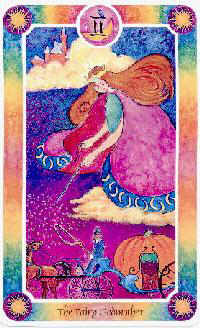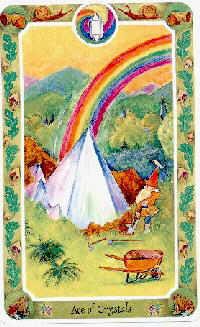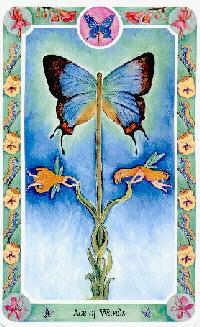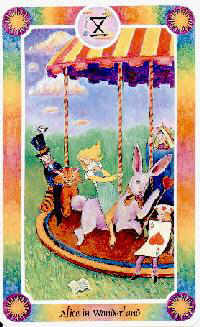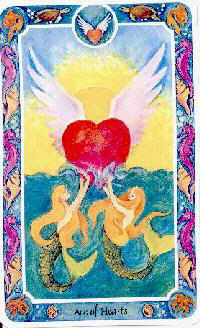Inner Child Cards Deck Review
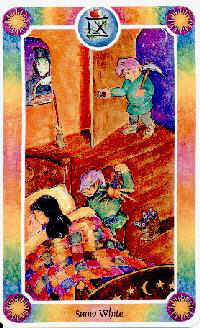
The Inner Child Cards are large cards with vibrant, attractive artwork in primary colours that looks a little like it was drawn with crayons. Journey into fairy tales, myths, and nature and back into childhood.
Deck Type: Tarot Deck Cards: 78
Creators: Isha Lerner, Mark Lerner, Christopher Guilfoil
Publisher: Bear & Co 1992
Retailers
See Price at Amazon.comSee Price at Amazon.co.uk
See Price at Amazon.ca
Inner Child Cards Review by Violet Gargoyle
I am a collector of Tarot cards, more than I am a reader of them. The oil painting-like artwork for this deck is beautiful. The artist utilizes bold and rich colors in keeping with its faerie tale theme.
Each card in the deck represents a character in a folk or faery tale. The Major Arcana runs its choices parallel to the archetypes in the typical tarot. For instance, the Fool card (Number Zero) is represented in this deck by Little Red Cap (the forerunner to Red Riding Hood). The High Priestess is the Faery Godmother, the Moon is represented by Cinderella, the Devil is represented by the Big Bad Wolf (a foil to Red Riding Cap and the Three Little Pigs, another card in the Major Arcana).
The titles of the cards are the names of the characters, not the archetypes (which are only noted in the book), so parents won't need to be squeamish in trying to explain to curious little seekers what the Magician means instead of pointing out Aladdin's Genie. The cards themselves are larger than normal decks (and harder to shuffle if you have smaller hands) but very detailed.
The minor arcana does away with the traditional court cards, meaning no kings or queens, but rather replaced with cards like The Seeker of Wands (all topped with butterfies) or the Guardian of Crystals.
The accompanying book to the deck is a nice read, but a thicker companion than many of the tarot decks that are on the market right now. Experts may want to skip to the source and insight areas detailing each card. Beginners may be more interested in the different layout and reading options.
This is a
good deck if you are a collector of childrens stories
or interested in folklore, and a fun one to look into
if you are looking for a bright
alternative/compliment to some more of the somber tarot decks that are
out there.
Inner Child Cards Review by Jen M
I actually found The Inner Child Cards here on this site. I was pretty much running through the entire alphabetic list here and I happened upon them. What first attracted me to the cards was the bright colors, since so many of the more popular decks are rather somber. The artwork on the cards posted on the web site was, in my opinion, incredible. Granted, the guy isn't Picasso, but he blends the rainbow in a most aesthetic way.The second thing I noticed (reading the other reviews and summaries) is that the Major Arcana are all based on Fairy Tales (when you get the deck you also see that the Court cards are based on a 'story' of some sort, as well). Major Arcana is supposed to be kind of the story of life, from birth to re-birth, and I could not *see* that in any other deck as well as I could with the Major Arcana of the Inner Child Cards. The symbolism of each Fairy Tale fit extremely well, and as I read through the book I also realized that the stories had each been fully researched as far back as the beginnings of the tale.
So, as they're not one of the more popular decks I had a hard time finding it. I eventually found it at a store called Vision Quest here where I live in Everett Washington. It was a little higher priced than most decks I was looking at (34.50$ I think), but in my opinion well worth it. You can't tell from just looking at the box but the book is very thick and thorough. There are 2 - 3 pages on every major arcana and court card and a full page devoted to each regular suit card, as well as a great foreword, which totally shows how much the authors cared about their project. The authors were also very thorough in adding numerology, astrology, and chakra points of view to their layouts and definitions of the cards. The book also has some deck-specific layouts that I had not seen before, including one that is fairly close to the the classic Celtic Cross, one devoted to chakras, etc. The only thing I didn't like about this part is that they were not as thorough as to what the positions meant, which I had gotten quite used to. But the more I read with the cards the more I developed, in my own head, what each position meant.
Each of the courts (Magic Wands-Fire-South, Swords of Truth-Air-East, Winged Hearts-Water-West, and Earth Crystals-Earth-North) stay very true to their Elemental associations, and where as some decks go a little cheesy with the regular old number cards, each and every card in this deck has as much powerful symbolism as the next. My favorite number cards would have to be the Nine of Swords and the Ten of Swords, because in most decks the symbolism never really got through to me, as much as in this deck, and those are personally powerful cards to me.
The cards themselves are very large and sturdy, and learning to shuffle them was... different... but since I couldn't shuffle before I got them, and now I shuffle extremely well, I apparently got over that. (Bending them and flexing them for the first five days really helped).
The Court cards are changed a bit from the average Tarot deck. Instead of Page, Knight, Queen and King, they are Child, Seeker, Guide, and Guardian. Each of these cards hold a fairy tale of their own, the Pied Piper, Dorothy, the Tin Man, and the Cowardly lion, and St. Nicholas make appearances. I didn't think I would be able to connect well with the difference but it ended up working better for me.
I think if I had to pick one specific thing I did not like about this deck it would be the use of angels in some of the cards. Raphael, Michael and Gabriel (Changed to Gabrielle) to be specific. I, along with allot of people in alternative religions do *not* connect well with the symbolism of angels. But since the angels do come with a 'story' of their own, I think it still fits with the theme, and if I ignore the whole religion thing, I still manage to deal well with the symbolism, it is still an archetype after all.
So in an over-all review of this deck: If you love bright colors, bouncing
on beds, laughing and playing in the park, you might want to give these
cards a try. They really can brighten your day.
Inner Child Cards Review by Sonia Reid
The Inner Child Cards are a fantasy deck which takes you on a journey into fairytale, myth and nature. The pretty colourful cards look like crayonned paintings, a nice touch that complements the child connection.
The cards are very large (5cm x 15.5cm) making them quite difficult to shuffle, but on the other hand the larger size helps you to see the detailed artwork very clearly.
The Major Arcana is designed to assist exploration of the mystery of the Divine Child who lives within each one of us. It takes us on a journey into a fairytale world inhabited by dragons,handsome princes, enchanters, big bad wolves and wicked witches, as well as many other traditional storybook characters.
These cards have rainbow hued borders, with the number of the card (Roman numerals) inset in a circle at the top. The title appears on the bottom border, but all 22 cards have been renamed, and I found it somewhat difficult to remember which of the traditional cards each one related to. It was easy enough to make the connection between the Fairy Godmother and High Priestess, Big Bad Wolf and The Devil, Sleeping Beauty and Death, Hansel & Gretel and The Lovers. But the connection between Three Little Pigs and Judgement, and Peter Pan and The Chariot was somewhat obscure and the connection not instantly made.
The design of this deck incorporates a very important change within the tarot, in that the Minor Arcana, projects a strong spiritual energy and presence. It is as though the magic and mystery of the Major Arcana has impregnated the Minor Cards, lifting them out of their usual supporting role.
The very pretty Magic Wands (Wands) show fairies and butterflies within borders of flowers and caterpillars. The Swords show children on adventures. Their borders show birds flying through purple skies bedecked with gold clouds. Winged Hearts (Cups) feature mermaids within borders of seashells, seahorses, turtles, starfish and goldfish. The Crystals (Pentacles) show gnomes in a border of acorns, oakleaves, toadstools, frogs and snails.
The traditional court figures have been renamed: the Page is now the Child, the Knight is called the Seeker, the Queen has become the Guide and the King is the Guardian.
Gaia, Caretake of the Earth appears as Guardian of the Crystals, with three Archangels as the remaining Guardians. Archangel Raphael, guardian to all travellers and people on religious pilgrimages and often depicted with a staff, is the Guardian of the Magic Wands. Archangel Michael who captains the heavenly hosts and carries the Sword of Truth is shown here as the Guardian of Swords. Archangel Gabriel, the revealer of divine mysteries to humanity is the Guardian of Winged Hearts.
Both Major and Minor Arcana cards have a sense of innocence and wonder about them and the borders give a sense of stepping into a scene from the pages of a storybook.
The Inner Child cards are a gateway to the lost innoncence of childhood, and are eminently suitable for reflective/meditative work aimed at contacting the wounded child within. I found them to also be a very accurate predictive tool, whilst projecting a sense of light heartedness and fun into readings.
A thoughtful and well written book accompanies this deck. There were several new spreads, charmingly named in keeping with the "child" theme. Simple to layout, and easy to remember, there was great depth to many of them. I particularly liked the 5 card spread entitled "Child", in which each of the cards represents an aspect of yourself. "C" shaped liked the crescent moon represents your receptivity to the world around you. "H" shaped like a ladder reveals how you climb higher within yourself to reach new spiritual undertaking. "I" is the central letter in the word "Child" and denotes a central reality or special goal. "L" stands for new life and represents the future, and finally "D" is for doorway which signifies the quintessential you - that unique aspect of your life that is hard to fathom and impossible to describe.
The Inner Child cards are a magical deck. Approach
with childlike wonder. 4 stars.
Inner Child Cards Review by Bonnie Cehovet
This is a unique deck, based on "fairy tales, myth and nature". The premise is firmly set in the foreward with the following: "We are not human beings having spiritual experiences as much as we are spiritual beings having human experiences, and the Tarot is a language articulating the soul's spiritual journey through the distinctly human domain."
The authors take the Tarot archetypes, meld them with childhood fantasy, and present us with a coherent picture of the soul's journey as viewed from the memories of childhood stories. (As an aside - both Isha and Mark Lerner are also professional astrologers.)
The Lerners posit that through childhood stories we are able to discover our creative muse. My interpretation - we enter the stories through the eyes of a child, and slowly we come to terms with their internal messages - with the archetypes of love, honor, healing, the need for change etc.
This deck was created for use by parents, teachers and families. The wisdom was kept in the archtypes of the major arcana, but combined with the innocence and joy of childhood. An interesting point that the authors make is a reference to Joseph Campbell's take on the Tarot - that each new deck reflects the existing culture and class distinctions in the court cards and the suits.
The Lerners recommend that all cards remain upright - that no attempt be made to read reversed cards in any manner. IMHO - this is an acceptable practice. In my own readings, I do not use reversed cards. If one were to show, in some magical way, I would tend to read it merely as blocked energy.
Several different spreads are present, including a basic three card spread, a ten card spread that the authors have named "hopscotch", along with an interesting major arcana 22 card spread called the Spiral Staircase - meant to cover the first twenty-two years of a childs life.
The major arcana themselves are presented in an interesting manner - there is a chart listing the name of the card, it's astrological ruler, and a keyword (keyed to the stories represented).
The cards themselves are done in soft colors, very much in *fairy tale* style. I have chose three cards - one from the major arcana,one court card and one pip to illustrate how this deck is presented. At the end of the presentation of each card, the traditional name and the planetary influence are given.
The traditional Empress has become Mother Goose. We see a crone, wearing an orange pointed hat and carrying a basket, seated upon a goose that appears to be flying. She is the personification of the earth mother, offering the abundance of life to all souls. You are advised to open yourself to the new potential within you.
The traditional Queen of Pentacles becomes the Guide of Earth Crystals. The card depicts the character of Saint Nicholas - red suit, white trim, long white beard, reindeer, Christmas tree and bag of gifts! The Guide of Crystals is said to represent the Lord of Earth - there is even a rabbit bounding through the snow representing fertility! When this card shows in a reading, you have been blessed in many ways. You are advised to explore this well of abundance and kindness that is there for you to draw on. (Interesting note - the Guide is presented as a male figure, the Guardian as a female figure in all of the suits.)
The 8 of Swords has become the 8 of the Swords of Truth. The card depicts eight children walking through a cave, one after the other, holding up lighted candles. When this card comes into a reading, it is viewed as the beginning of a sacred journey, a cleaning of the house of your psyche.
I was immediately drawn to this deck, and found it very easy to work with. My mother, who is not a Tarot afficionado, announced that she wanted to read the book and study the cards from this deck (major coup!). The day that I received these cards, a friend who is actively *not* drawn to the Tarot e-mailed me with a site that had these *neat cards* that she was using as a card-a-day type draw because she found them soothing and - yes, it was the Inner Child deck!
Thumbs up on this one - for general reading, meditation and spiritual advice. The only drawback is the size - the are approximately one and one-half times the size of a regular Tarot deck - so anyone with small hands will have to find an alternative way of shuffling. The journey is worth it.
Inner Child Cards Review by Remi Daily
Once upon a time, Mark and Isha Lerner came together and created a deck full of archetypal childhood stories as means to communicate the Tarot with children and those who are young at heart- our inner child. Four years in the making, The Inner Child Cards feature fairies, gnomes, deceptive animals, knights, and princesses melded with the culture of the Tarot where demons and other deeper and sometimes dark characters are perceived to be alive within us all.
Fables and fairy tales are often moral lessons to be learned and carried throughout life’s journey. As we grow older, we forget about these stories and the Inner Child Cards remind us of these lessons in magnificent, Technicolor usage of fairy-tale images. The combination of fairy tale personalities and the teachings of human psychology found in the Tarot make for famed narratives useful to any Tarot user.
In this deck the four suites are Wands (depicted as butterflies), Swords, Hearts (depicted as winged hearts), and Crystals. In traditional Tarot, Cups always represent emotions and this is where the Lerners have integrated the icon of Hearts. I especially enjoy the switch from Pentacles to Crystals in this deck as it conveys the full meaning of prosperity: material, earthly, physical, and emotional. Other changes include the royal court where Child=Page, Seeker=Knight, Guide=Queen, Guardian=King and the naming of the individual major arcana cards reflecting the themes behind many fables (i.e. Hansel and Gretel as the Lovers, The Yellow Brick Road as Strength, Cinderella as the Moon , etc.).
The large book included with this deck serves as the illuminating waters for the cards. The book, about 291 pages, gives one a complete explanation of the cards the way the creators have envisioned them. Also, there are six highly innovative card layouts presented by the Lerners: the CHILD, Hopscotch (a Kabbalah Tree of Life spread), Wishing Well, Rainbow, Spiral Staircase, and a simple new take on the three-card spread layout called What’s Around the Corner.
The deck fully takes advantage of vibrant primary color combinations and a wonderful use of symbolism. I have chosen to share a few of my favorite cards and also other cards randomly picked from the deck in order to perform the five-card CHILD spread:
C=1st card: Represents your receptivity to the world around you.
The Star- In the time of twilight you see a huge star, similarly depicted in nativity scenes over Bethlehem, a youth steps up to drop a coin into a water well. Underneath is the caption “Wishing Upon A Star.” Traditionally the Star card in Tarot tells us about inspiration, beauty, inner guidance, and hope but it also asks us to take all of these things and step up to the plate, applying a little elbow grease in achieving what we want while holding onto our dreams.
H=2nd card: Dictates how you climb higher within yourself to reach a new level of spirit and understanding.
The Eight of Crystals- Shows us a little female gnome in a pair of skates etching into the ice the figure (number) eight. In the world of ice skating, perfecting the figure eight requires work and patience and signifies a transformation of talent from being a novice skater to one with more skill. The figure 8 also represents the infinite, reaching our infinite potential in an endeavor.
I=3rd card: Symbolizes individuality, independence and developing within.
Four of Swords- Four youthful boys are steering a log raft down the river with their swords, while one of them is fishing. Four of Swords traditionally indicates rest. In this card the fishing youth is the odd one out, for the Lerners fishing is the equivalent to rest and relaxation of the mind. This card tells one not to rush the mental process, let your mind rest and free itself in order to bring forth the messages you need to know in order to take charge in life’s upcoming journeys.
L=4th card: The new life you are constantly creating.
Two of Hearts- A card of two mermaids sitting on two separate rocks on the shore. Each is holding a winged heart connected by a rainbow with dolphins flying high above.
The rainbow represents a connection and the dolphins represent spirit/mind. Two of Cups traditionally represent a connection of love or attraction between two individuals. The card capitalizes on the mind aspect of the Two of Cups, lending a friendship partnership feel.
D=5th cared: Your doorway into the world and the challenges one might face.
Guardian of Wands- This card is different in its connotation than many Rider-Waite interpretations. This card is the card of spiritual healing and travels. Archangel Raphael is the ruler of this card and can be further explored by Raphael’s association with King Solomon.
The cards are intentionally big (3 8/16” by 6 ¼”) which is a lot of room to incorporate many symbols and images without them being cluttered. However, the sizing can make the cards difficult to shuffle (which was also an intentional aspect of the cards when created so that one can grasp the concept of youth and having everything surrounding us as being large and inaccessible) and through trial and error I’ve found my own way to shuffle the cards at the corners while holding them vertical. The backs of the cards are of a deep purple with a blazing emblem of a yellow sun and are reversible. The card stock is durable but does not appear to have a protective glossy coating over them. The packaging holds both the book and cards in a box. It is hard to find a bag to fit the cards, but at the same time the packaging it comes in looks fashionable tucked upon a bookcase.
My personal experiences with this deck have been ennobling. I call the Inner Child Cards my “Pluto” deck. Even though it appears as a deck with a light-hearted theme, this is a very serious deck that reaches to the heart of the matter and has the ability to ferret out excess energies in order to find solutions to a problem. I reach for this deck in conjunction with other decks during a read if a problem is indicated. Inner Child Cards also serve as an oracle of sorts because the Lerners’ interpretations of the cards are always positive with a different outlook than the traditional Raider-Waite meaning. However, one can also throw out the meanings the Lerners have for the cards and easily use it in regular Rider-Waite or Golden Dawn form and have as revealing messages. The Lerners suggest using only upright meanings. I am an advocate of utilizing reversed cards during a read, but this is personal preference. The way the selected images on these cards are laid out on the cardstock makes interpretation of reversed cards a breeze.
Inner Child Cards appeal and work best for those who are familiar with fables and fairy-tales. The stories/symbols associated with each card allow for deeper meditation and meaning. Those who love bright colors will be drawn to this deck. Those who are really interested in the way color, numbers, and astrology work in the Tarot will find this deck amazing as the accompanying book taps into the culmination of these ancient traditions. This is an excellent purchase for the experienced Tarot muse looking for something deeper yet unique and also for the non-experienced Tarot user fascinated by fairy-tales and fables.
Complete Details of Inner Child Cards
Creators: Isha Lerner, Mark Lerner, Christopher GuilfoilPublisher: Bear & Co 1992
Deck Type: Tarot Deck
Cards: 78
Major Arcana: 22
Minor Arcana: 56
Deck Tradition: Mixed
Minor Arcana Style: Unique Scenes With Suit Symbols
Suits: Wands, Swords, Hearts, Crystals
Court Cards: Child, Seeker, Guide, Guardian
Major Titles: Little Red Cap, Aladdin and the Magic Lamp, The Fairy Godmother, Mother Goose, The Emperor's New Clothes, The Wizard, Hansel and Gretel, Peter Pan, Beauty and the Beast, Snow White, Alice in Wonderland, The Midas Touch, Jack and the Beanstalk, Sleeping Beauty, The Guardian Angel, The Big Bad Wolf, Rapunzel, Wishing on a Star, Cinderella, The Yellow Brick Road, The Three Little Pigs, The Earth Child
The Fool is 0
Strength is 8
Justice is 11
Card Size: 6.30 x 3.94 in. = 16.00cm x 10.00cm
Card Language: English
Card Back: Non-reversible
Back Design: Purple back with a yellow sun
Companion Material: 336 page illustrated hardcover book
Rating: 16/20 or
Similar Decks to Inner Child Cards
Theme: Children, Fairy TalesCreator: Baseball Tarot by Mark Lerner Tarot of the Four Elements, Triple Goddess Tarot by Isha Lerner
< Previous Deck · Back to Top · Next Deck >
Home > Tarot Reviews > Inner Child Cards Review

